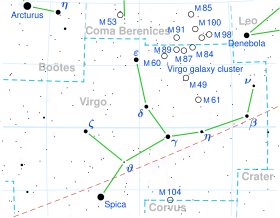Spica
| Observation data Epoch J2000 Equinox J2000 |
|
|---|---|
| Constellation | Virgo |
| Pronunciation | /ˈspaɪkə/ |
| Right ascension | 13h 25m 11.579s |
| Declination | −11° 09′ 40.75″ |
| Apparent magnitude (V) | +0.97(0.97 - 1.04) |
| Characteristics | |
| Spectral type | B1 III-IV/B2 V |
| U−B color index | −0.94 |
| B−V color index | −0.23 |
| Variable type | β Cep + Ellipsoidal |
| Astrometry | |
| Radial velocity (Rv) | +1.0 km/s |
| Proper motion (μ) |
RA: −42.35 ± 0.62 mas/yr Dec.: −30.67 ± 0.37 mas/yr |
| Parallax (π) | 13.06 ± 0.70mas |
| Distance | 250 ± 10 ly (77 ± 4 pc) |
| Absolute magnitude (MV) | −3.55 (−3.5/−1.5) |
| Orbit | |
| Period (P) | 4.0145898 d |
| Eccentricity (e) | 0.067 ± 0.014 |
| Inclination (i) | 54 ± 6° |
| Periastron epoch (T) | 2440678.09 |
|
Argument of periastron (ω) (secondary) |
140 ± 10° |
| Details | |
| Primary | |
| Mass | 10.25 ± 0.68 M☉ |
| Radius | 7.40 ± 0.57 R☉ |
| Luminosity | 12,100 L☉ |
| Surface gravity (log g) | 3.7 ± 0.1 cgs |
| Temperature | 22,400 K |
| Rotational velocity (v sin i) | 199 ± 5 km/s |
| Secondary | |
| Mass | 6.97 ± 0.4 M☉ |
| Radius | 3.64 ± 0.28 R☉ |
| Luminosity | 1,500 L☉ |
| Temperature | 18,500 K |
| Rotational velocity (v sin i) | 87 ± 6 km/s |
| Other designations | |
| Database references | |
| SIMBAD | data |
Spica (/ˈspaɪkə/), also designated Alpha Virginis (α Virginis, abbreviated Alpha Vir, α Vir), is the brightest star in the constellation of Virgo and the 16th brightest star in the night sky. Analysis of its parallax shows that it is located 250 ± 10 light years from the Sun. It is a spectroscopic binary and rotating ellipsoidal variable; a system whose two main stars are so close together they are egg-shaped rather than spherical, and can only be separated by their spectra. The primary is a blue giant and a variable star of the Beta Cephei type.
Spica, along with Denebola or Regulus depending on the source and Arcturus, is part of the Spring Triangle asterism, and by extension, also of the Great Diamond together with the star Cor Caroli.
As one of the nearest massive binary star systems to the Sun, Spica has been the subject of many observational studies.
Spica is believed to be the star that gave Hipparchus the data that led him to discover the precession of the equinoxes. A temple to Menat (an early Hathor) at Thebes was oriented with reference to Spica when it was built in 3200 BC, and, over time, precession slowly but noticeably changed Spica's location relative to the temple.Nicolaus Copernicus made many observations of Spica with his home-made triquetrum for his researches on precession.
...
Wikipedia

